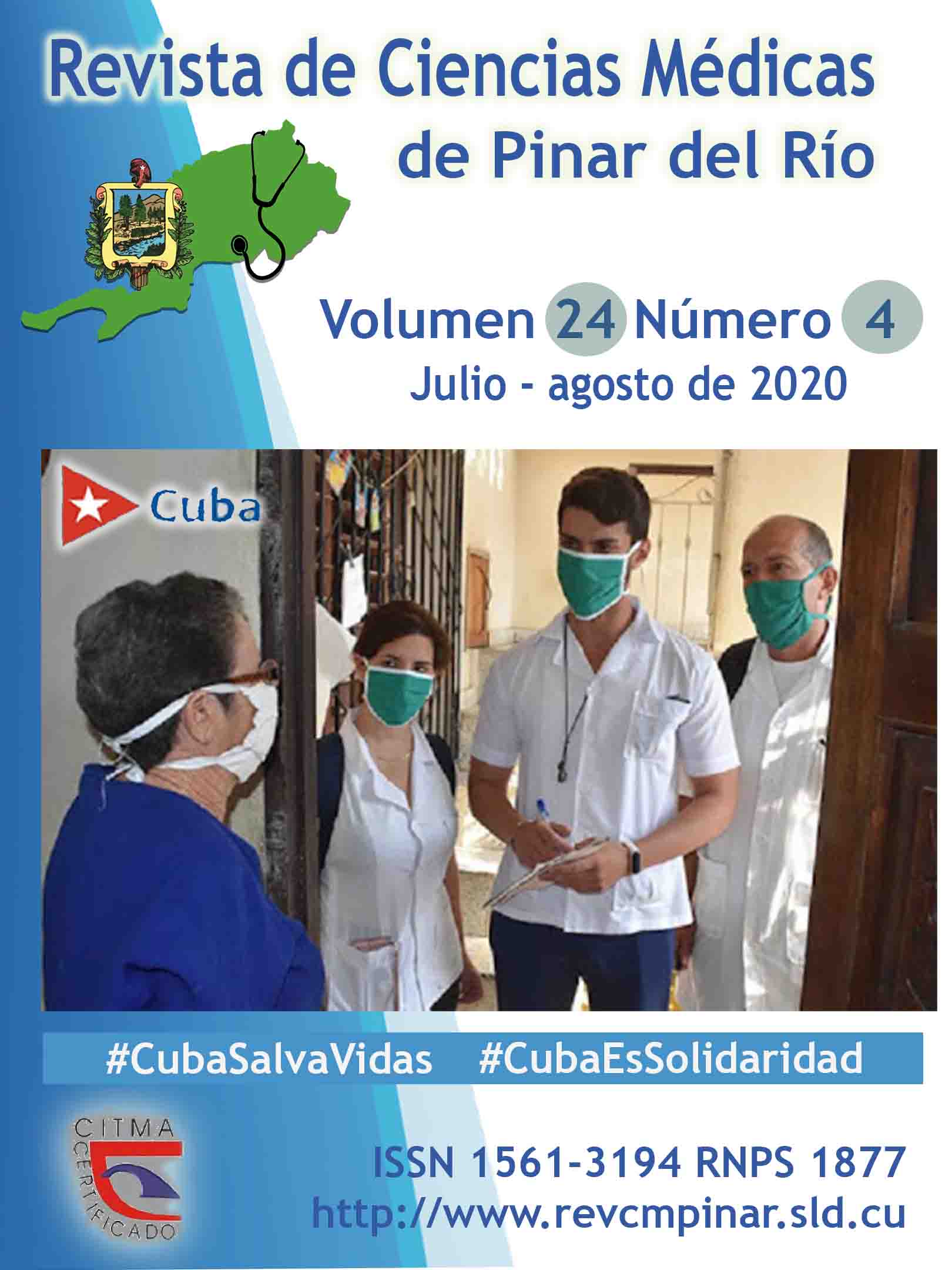Hemorrhagic risk factors according to HAS-BLED score in patients with non-valvular atrial fibrillation
Keywords:
ATRIAL FIBRILLATION, STROKE, RISK FACTORS.Abstract
Introduction: atrial fibrillation is the most common arrhythmia; its prevalence increases with age and is a risk factor for the development of cerebrovascular disease.
Objective: to identify hemorrhagic risk factors according to HAS-BLED score in patients with permanent non-valvular atrial fibrillation treated at Dr. Leon Cuervo Rubio Provincial Clinical-Surgical-Teaching Hospital in Pinar del Río.
Methods: an observational, descriptive and cross-sectional research was conducted in patients attended Dr. Leon Cuervo Rubio Provincial Clinical-Surgical-Teaching Hospital between July 2017-July 2018. The population consisted of 130 patients with permanent non-valvular atrial fibrillation, 80 of them were studied by simple random sampling. The HAS-BLED score was applied to identify hemorrhagic risk factors.
Results: fifty seven point fifty percent (57,50 %) of the patients studied belonged to 78-97year age group and 65 % were represented by male sex. Seventy-five percent was white race. According to the HAS-BLED score, the most common risk factor was in patients over 65 years (75 %) and 73 % of the patients presented a high risk of bleeding.
Conclusions: Atrial fibrillation is the most frequent arrhythmia as age progresses, with a negative impact on the quality of life of patients who suffer from it, due to the complications that arise.
Downloads
References
1. Reyes Sanamé FA, Pérez Álvarez ML, Alfonso Figueredo E, Núñez Molina B, Jiménez Rodríguez K. Fibrilación auricular. Panorámica sobre un tema actualizado. CCM [Internet]. 2018 Dic [citado 06/12/2019]; 22(4): [Aprox 23p.]. Disponible en: http://scielo.sld.cu/scielo.php?script=sci_arttext&pid=S1560-43812018000400014&lng=es
2. Forero-Gómez E, Moreno JM, Agudelo CA, Rodríguez-Arias EA, Sánchez-Moscoso PA. Fibrilación auricular: enfoque para el médico no cardiólogo. LATREIA [Internet]. 2017 [Citado 02/12/2019]; 30(4): [Aprox 22p.]. Disponible en: http://www.scielo.org.co/pdf/iat/v30n4/0121-0793-iat-30-04-00404.pdf
3. Marín F. Fibrilación Auricular Estándar de Calidad SEC Proceso. Soc española de cardiología [Internet]. 2018 [Citado 02/12/2019]: [Aprox 73p.]. Disponible en: https://secardiologia.es/images/SEC-Excelente/Proceso_FA_20180309.pdf
4. Fortuny Frau E. Validación de la escala de riesgo hemorrágico HAS-BLED en una población hospitalaria de nuestro medio [Tesis]. Madrid: Universidad Complutense; 2018. [Citado 02/12/2019]. Disponible en: https://eprints.ucm.es/46952/1/T39735.pdf
5. Mateo J. Avances en anticoagulación oral: papel del rivaroxabán. Rev Esp Cardiol [Internet]. 2013 [Citado 04/12/2019]; 13(C): [Aprox 4p.]. Disponible en: https://www.revespcardiol.org/es-nuevos-anticoagulantes-orales-su-papel-articulo-S1131358713700578
6. Pérez-Copete J, Asunción Esteve-Pastor M, Roldán V, Valdés M, Marín F. Fibrilación auricular Escalas de evaluación del riesgo tromboembólico y hemorrágico en la fibrilación auricular. Rev Esp Cardiol Supl. [Internet]. 2016 [Citado 02/12/2019]; 16(Supl 1): [Aprox 7p.]. Disponible en: https://www.sciencedirect.com/science/article/abs/pii/S1131358716300115
7. Guindo Soldevila J, Martínez Ruíz MD, Duran Robert I, Tornos P, Martínez-Rubio A. Evaluación de riesgo tromboembólico y hemorrágico de los pacientes con fibrilación auricular. Rev Esp Cardiol [Internet]. 2013 [Citado 02/12/2019]; 13(C): [Aprox 4p.]. Disponible en: https://www.revespcardiol.org/es-evaluacion-riesgo-tromboembolico-hemorragico-los-articulo-S1131358713700530
8. Velásquez JE, Sebastián Naranjo MC, Mauricio Duque G. La fibrilación auricular y su comportamiento en la mujer. Revista Colombiana de Cardiología [Internet]. 2018 [Citado 02/12/2019]; 25(Supl 1): [Aprox 4p.]. Disponible en: https://www.sciencedirect.com/science/article/pii/S0120563317302504
9. Gómez-Doblasa JJ, López-Garrido MA, Esteve-Ruiz I, Barón-Esquivias G. Epidemiología de la fibrilación auricular. Rev Española de Cardiología [Internet]. 2016 [Citado 03/12/2019]; 16(1): [Aprox. 5p.]. Disponible en: https://www.revespcardiol.org/en-epidemiologia-fibrilacion-auricular-articulo-S1131358716300073
10. Moreno Peña LE, Hernández Hervis IT, Moreno Peña R, García Peñate G, García García D. Conducta antitrombótica en pacientes con fibrilación auricular e ictus isquémico. Hospital Faustino Pérez. Año 2017. Rev Med Electrón [Internet]. 2018 Jun [Citado 2019 Dic 02]; 40(3): [Aprox 11p.]. Disponible en: http://scielo.sld.cu/scielo.php?script=sci_arttext&pid=S1684-18242018000300012&lng=es.
11. López-Sendóna J, Merinob JL. Nuevos tratamientos anticoagulantes para la prevención del ictus y la embolia sistémica en la fibrilación auricular. Rev Esp Cardiol Supl [Internet]. 2012 [Citado 02/12/2019]; 12(2): [Aprox 6p.]. Disponible en: https://www.sciencedirect.com/science/article/abs/pii/S1131358712700468
12. Fernández Arranz M. Situación del riesgo de embolia y de hemorragia según las escalas CHADS₂, CHA₂DS₂-VASc y HAS-BLED en pacientes con diagnóstico de fibrilación auricular crónica, en un centro de salud de Madrid [Tesis]. Madrid: Universidad Complutense; 2016 [Citado 02/12/2019]. Disponible en: https://eprints.ucm.es/38911/1/T37694.pdf
Downloads
Published
How to Cite
Issue
Section
License
Authors who have publications with this journal agree to the following terms: Authors will retain their copyrights and grant the journal the right of first publication of their work, which will be publication of their work, which will be simultaneously subject to the Creative Commons Attribution License (CC-BY-NC 4.0) that allows third parties to share the work as long as its author and first publication in this journal are indicated.
Authors may adopt other non-exclusive license agreements for distribution of the published version of the work (e.g.: deposit it in an institutional telematic archive or publish it in a volume). Likewise, and according to the recommendations of the Medical Sciences Editorial (ECIMED), authors must declare in each article their contribution according to the CRediT taxonomy (contributor roles). This taxonomy includes 14 roles, which can be used to represent the tasks typically performed by contributors in scientific academic production. It should be consulted in monograph) whenever initial publication in this journal is indicated. Authors are allowed and encouraged to disseminate their work through the Internet (e.g., in institutional telematic archives or on their web page) before and during the submission process, which may produce interesting exchanges and increase citations of the published work. (See The effect of open access). https://casrai.org/credit/



